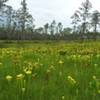Abstract
Florida is home to one of North America’s most unique and diverse ecosystems, the seepage slope. Unusual hydrology and frequent fires combine to create an environment that supports a variety of carnivorous and other sun-loving herbaceous plants. This 5-page fact sheet discusses the natural history and conservation concerns associated with seepage slope wetlands. Written by Megan E. Brown and Debbie L. Miller, and published by the UF Department of Wildlife Ecology and Conservation, June 2012.
References
Arrington, D. A., L. A. Toth, and J. W.Koebel.1999. Effects of rooting by feral hogs Sus scrofa L. on the structure of a floodplain vegetation assemblage. Wetlands 19(3):535-544, https://doi.org/10.1007/BF03161691
Clewell, A. F. 1986. Natural setting and vegetation of the Florida Panhandle: An account of the environments and plant communities of northern Florida west of the Suwannee River. Report No. COESAM/PDEI-86/001. United States Army Corps of Engineers, Mobile District, Alabama.
Engeman, R. M., A. Stevens, J. Allen, J. Dunlap, M. Daniel, D. Teague, and B. Constantin. 2007. Feral swine management for conservation of an imperiled wetland habitat: Florida's vanishing seepage slopes. Biological Conservation 134(3):440-446. https://doi.org/10.1016/j.biocon.2006.08.033
Florida Fish and Wildlife Conservation Commission (FWC). 2005. Florida's Wildlife Legacy Initiative. Florida's Comprehensive Wildlife Conservation Strategy. Tallahassee, Florida, USA.
Florida Natural Areas Inventory (FNAI). 1990. Guide to the natural communities of Florida. Florida Natural Areas Inventory and Florida Department of Natural Resources, Tallahassee, FL.
Florida Natural Areas Inventory (FNAI). 2010. Guide to the natural communities of Florida: 2010 edition. Florida Natural Areas Inventory and Florida Department of Natural Resources, Tallahassee, FL.
Folkerts, G. W. 1982. The Gulf-Coast Pitcher Plant Bogs. American Scientist 70(3):260-267.
Frost, C. 2006. History and Future of the Longleaf Pine Ecosystem. Pp 9-42 In Shibu J, Jokela EJ, Miller DL, Eds. The Longleaf Pine Ecosystem: Ecology, Silviculture, and Restoration, Springer, New York, NY. https://doi.org/10.1007/978-0-387-30687-2_2
Hermann, S. M. 1995. Status and management of Florida's carnivorous plant communities. Nongame Wildlife Program project no. GFC-84-033. Florida Fish and Wildlife Conservation Commission, Tallahassee, Florida.
Jensen, A. 1985. The effect of cattle and sheep grazing on salt-marsh vegetation at Skallingen, Denmark. Vegetatio 60:37-48. https://doi.org/10.1007/BF00053910
Johnson, E. D. 2001. Pitcherplants and their habitats in the Florida State Park system: resource conditions, trends, and management needs. Resource Management Evaluation. Division of Recreation and Parks, Florida Department of Environmental Protection, Tallahassee.
Mayer, J. J., and I. L. Brisbin. 1991. Wild pigs in the United States: Their life history, morphology and current status. University of Georgia Press, Athens, GA.
Olson, M. S. 1992. Effects of early and late growing season fires on resprouting of shrubs in upland longleaf pine savannas and embedded seepage savannas. Masters Thesis. Louisiana State University.
Olson, M.S., and W. J. Platt. 1995. Effects of habitat and growing season fires on resprouting of shrubs in longleaf pine savannas. Vegetatio 119:101-118. https://doi.org/10.1007/BF00045593
Tep, P., and K. Gaines. 2003. Reversing the impacts of feral pig on the Hawaiian tropical rainforest ecosystem. Restoration and Reclamation Review 8(3).
http://www.fnai.org/naturalcommguide.cfm
http://www.flmnh.ufl.edu/nwfla/bog.htm
http://www.alachuacounty.us/Depts/EPD/NaturalResources/whatare/Pages/Living_Wetland.aspx
http://www.nwflec.com/northwestfloridaenvironmentalconservancypart2/id11.html

